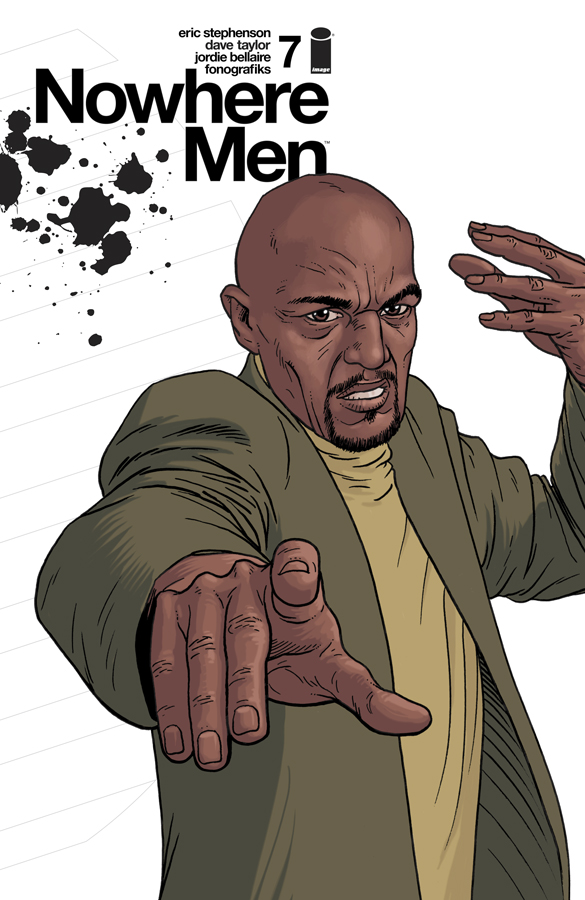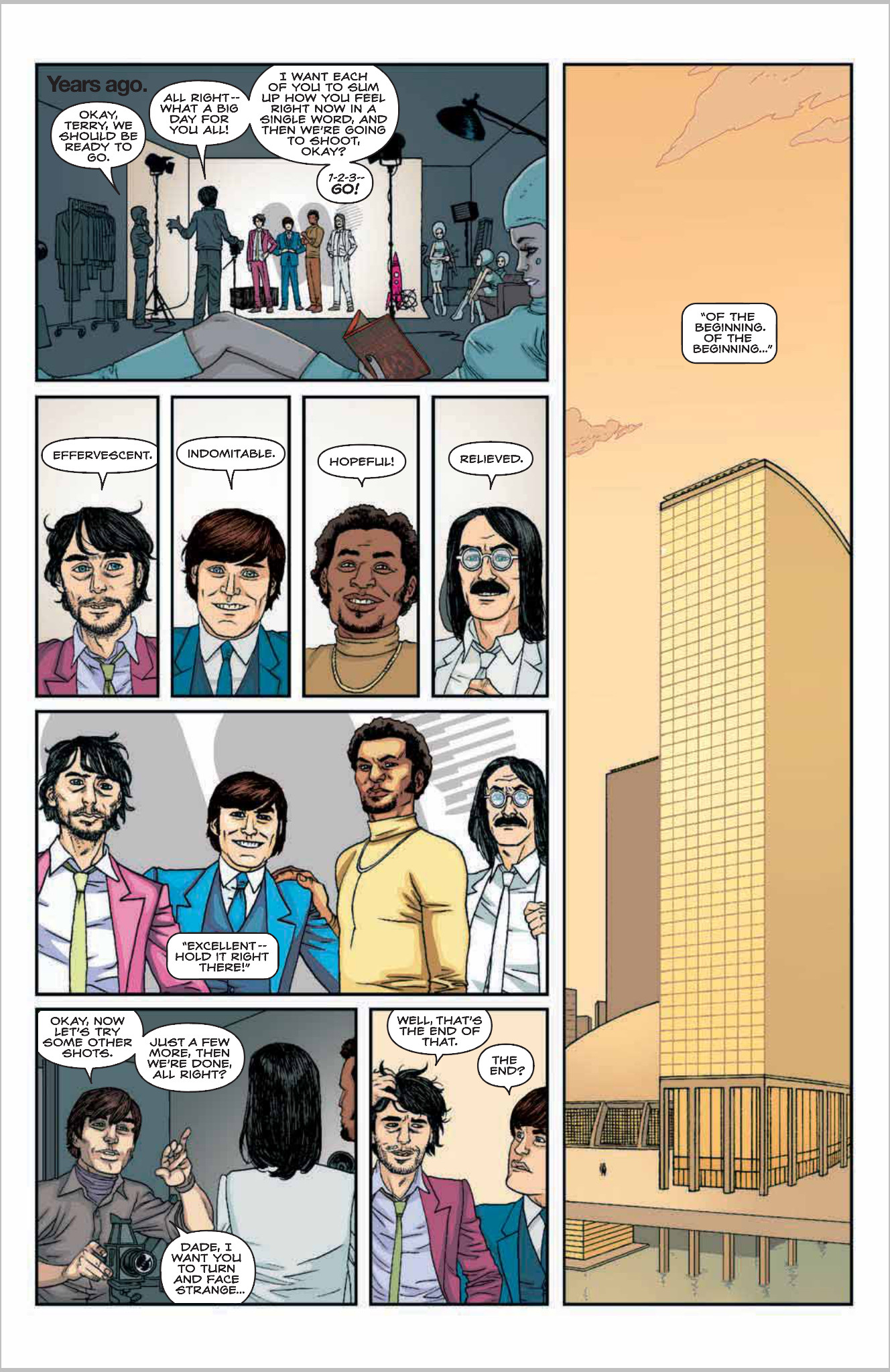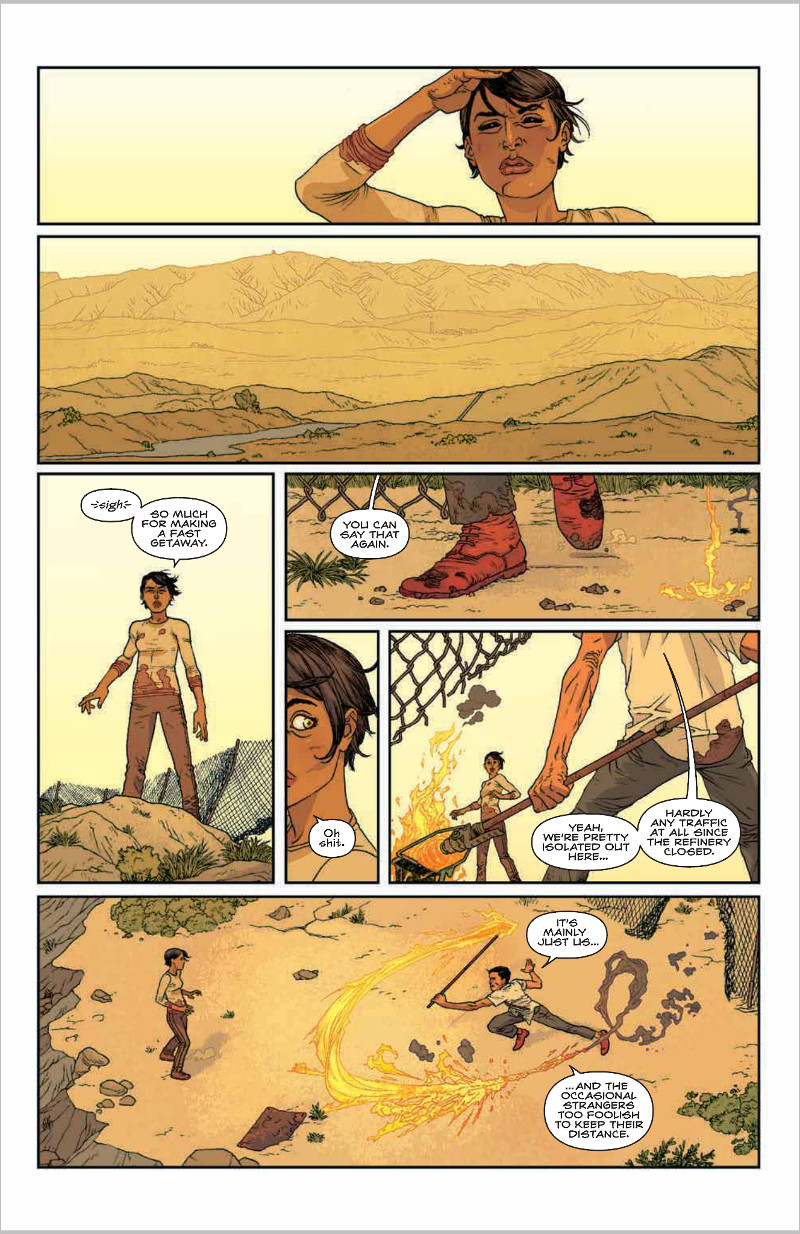Eric Stephenson on the Long Awaited Return of Nowhere Men
One of the trickiest places to be as a creator on a creator-owned comic is figuring out how to recover after an extended absence. After all, the comic industry and the way ordering works is, in a weird way, built on faith. When a book’s schedule slips, that can shake that faith in a very real way. That’s what the team of the Eisner nominated Nowhere Men, including writer and creator Eric Stephenson, is facing as its first issue in over two years is set to drop on January 20th. But they have an advantage over other books in their position: Nowhere Men was – and still is – an excellent comic.
Its return issue – #7 – kicks off a new arc and welcomes new series artist Dave Taylor to the book after its previous artist, Nate Bellegarde, left the book due to personal issues. This issue is very good news for fans of the book, and not just because the book is back. Having read an advance copy already, it shows that the book hasn’t lost a step in its absence and that Taylor is a fitting, capable replacement for Bellegarde. For those who weren’t sure about it’s return after such a long gap, trust me when I say that Nowhere Men is back in a big way.
With FOC today and retailers finalizing their orders on the book, I talked with Stephenson about the book’s return, how his approach did or didn’t change, how Taylor’s fitting into the book, how colorist Jordie Bellaire and designer/letterer Fonografiks have helped smooth the artist transition, what Stephenson’s doing to assuage reader and retailer concerns, and more. For those on the fence about the book’s return, give this interview a read, and by all means, pick the comic up upon it’s return. You’ll be happy you did.
 It’s been a bit over two years since the last issue of Nowhere Men, and we’re talking about a comic that is as dense as anything you’ll find in comics, really. Obviously you had a version of the script for #7 written long before, but given the time since the last issue and the amount of information you’re hoping to remind readers of, did you rework or rethink how you wanted this new arc to play out to help reengage readers with the story? Or is it very much dropping readers back into the middle of it?
It’s been a bit over two years since the last issue of Nowhere Men, and we’re talking about a comic that is as dense as anything you’ll find in comics, really. Obviously you had a version of the script for #7 written long before, but given the time since the last issue and the amount of information you’re hoping to remind readers of, did you rework or rethink how you wanted this new arc to play out to help reengage readers with the story? Or is it very much dropping readers back into the middle of it?
ES: The latter. Issues 1-12 are a single story, so it’s not like there’s a way to reintroduce the concept in a way that isn’t totally jarring.
Nate Bellegarde was a phenomenal fit for the book, even beyond being a superb artist. We know Dave Taylor’s a good artist, and from the press release, we know he was a fan of the book before becoming the artist on it. For you, though, what is it about his art that fits the books so well?
ES: Dave’s very detail-oriented and he does sci-fi very well. He did an issue of Prophet with Brandon Graham that I was really taken with, and I think he just has the right visual vocabulary for the book.
Does working with a new artist with different strengths change the way you write at all? Or is that something you’re still feeling out as this collaboration gets going?
ES: Well, given that Nate and I spent around four years on the first six issues, it is different. Nate and I created the book together and there was a lot of shorthand between us in terms of communication. That’s not something that happens overnight, it’s something that develops over time in a collaboration. I’m pretty sure I do all kinds of things that drive Dave crazy, just because I’m used to working with Nate or with Simon on They’re Not Like Us, and I’m still kind of figuring out how best to tailor things to Dave’s sensibilities. Fortunately enough for me, though, Dave is amazing and even though he may be cursing my name in private, every new page I see from him is better than the last.

Does having Jordie Bellaire and Fonografiks stay on the book as consistent art elements ease that transition at all in your opinion?
ES: Absolutely! It’s funny, too – when Jordie finished coloring issue seven, her partner Declan Shalvey emailed me to say how cool it was to see the whole thing come together, because it just looked like Nowhere Men, even though Dave is in no way a carbon copy of Nate. Jordie’s a big part of that, obviously, and so is Fonografiks.
The first issue back has a section that’s the diary of Emerson Strange’s daughter Monica. First off, good call on Emi Lenox drawing that part – perfect fit. But beyond that, Monica’s a character who feels important despite only a few references in the first volume, especially considering she’s the only family that’s been mentioned for any of the four leads. Is she destined to play a bigger part of the arc outside of the diary, and how did you decide you wanted to have another artist for that section?
ES: The main thing about having Emi do that was that I wanted to do something different than just the ads and interviews and stuff, but I didn’t want to overload Nate with more art responsibilities. Emi was my first and only choice, because I love her style. I’m a big fan of her own book, Emitown, and that was pretty much exactly what I wanted for Monica’s sketch diary. Why not go straight to the source?
And yeah, Monica is going to be a larger part of the book, and that should become pretty clear by the end of issue seven. Even though she isn’t in the first six issues, she’s one of the characters I’ve given the most consideration to, and there was a point when I almost wanted to do a Monica Strange series instead of actually doing Nowhere Men.
Rereading the first arc, one thing stood out more than the first time through: there’s no real “hero,” and if anything, even the idea of “good” is a matter of perspective. Even the ostensible “bad guy” – Simon Grimshaw – might be considered a hero for certain audiences. When it comes to the four leads, how important to you is keeping their motivations open to interpretation? And in your mind, is there someone you intend to be a “hero” of the story?
ES: I think you may have a different interpretation of things after the second arc ends.

After such a long gap, I’m sure you’ve been met with trepidation from both readers and retailers as to the future of the book. I have to imagine that’s something that’s been on your mind as you approach this next stage for the book – regaining their trust. What have you done ahead of time to ensure a stable future for the book, if only in a publishing sense?
ES: I think trepidation is understandable on both ends. There was a retailer who publicly called me out around the time They’re Not Like Us was first being solicited, saying that he couldn’t back a project I was doing because I was clearly spread too thin to maintain a deadline on Nowhere Men. That wasn’t the case, but you know, I get where retailers are coming from on that, and I tell other creators all the time – the last thing you want to do is ship your book late. It’s a fucking killer, man, and sorry for being so blunt, but there’s really no nice way to say it. Ship your book late, you’re fucking the reader, the retailer, and yourself. So you know, I’m going into this second arc very much aware of the fact that we might not be able to generate enough goodwill from the folks that matter to continue on past issue 12. I would like to, and I know the rest of the team would like to, but ultimately, it’s on us to get the book out and make it worth people’s whiles to let us back into their lives.
I’m sure you’ve been getting questions the whole time the book’s been on hiatus as to where the book is and when it’s coming back, which, for you, were likely questions you were asking as well. After taking so much time off, was it difficult at all to get yourself into the mindset to write this comic again? Or are you just happy to have the book up and running?
ES: There are certain things that are tough to get back to. The world as a whole is very easy to walk back into, but there are a few things that I’m looking at a bit differently now just because of where I’m at two years later.
Thomas Walker has effectively never appeared in the comic in any real-time sense. He’s been in flashbacks and been interviewed and varying other elements, but in the core thread of the story, he’s absent. Yet, in a weird way, he feels like the most essential part of the book and the measuring stick that the rest of World Corp holds themselves against despite turning on him. Why do you think that would be the case, and to you, what makes the character so interesting?
ES: He’s a man of mystery. We are all intrigued by the unknown, and in Walker’s case, his disappearance seems to have had a very profound effect on the world Strange, Ellis, and Grimshaw were constructing with World Corp, whether they realized that themselves or not. We’ll get into that more in the second arc, and if we get to do more after that, Walker will become even more important still.
Want to get back on the Nowhere Men train? Let your local comic book shop know you want to add it to your pull today!
